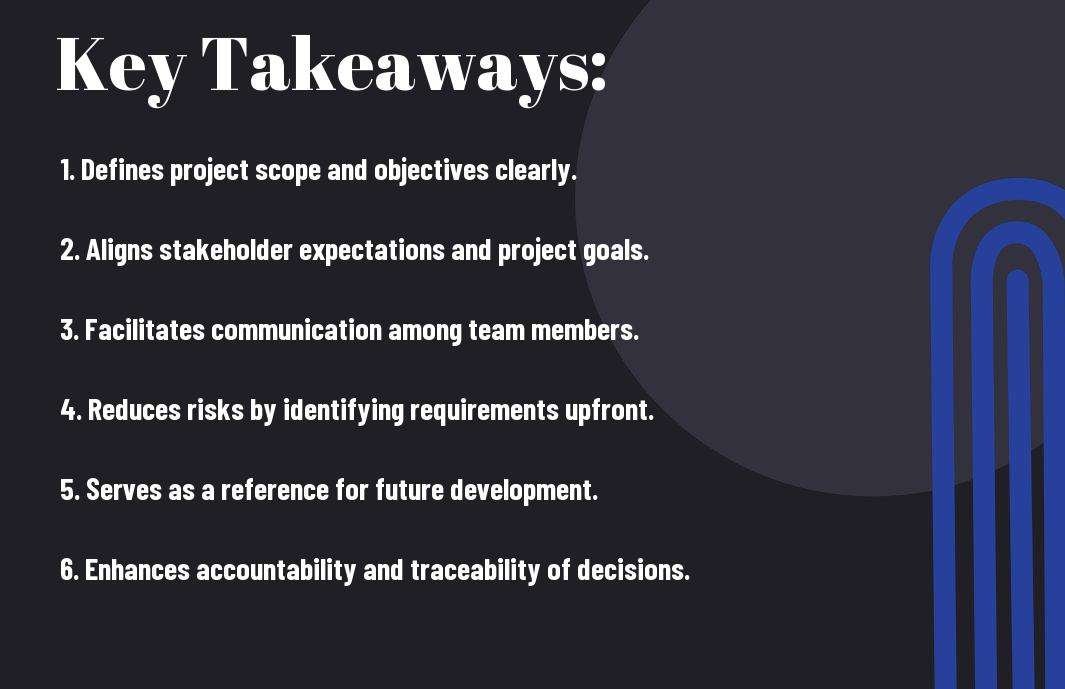Many professionals in product management often overlook the significance of the Business Requirements Document (BRD). In my experience, a well-crafted BRD serves as a foundational tool that aligns stakeholders, clarifies objectives, and outlines vital project details. When you invest the time to develop this document, you reduce the risk of costly misunderstandings and ensure your team’s efforts are streamlined. By leveraging the BRD, I can keep your project focused, enhance communication, and ultimately drive successful product outcomes that meet both business and customer needs.
Key Takeaways:
- Clarity: A well-defined Business Requirements Document (BRD) ensures that all stakeholders have a clear understanding of the project’s objectives and requirements, reducing the risk of miscommunication.
- Alignment: The BRD aligns the development team, product managers, and stakeholders by providing a shared vision, which facilitates a smoother product development process.
- Traceability: It serves as a reference point throughout the product lifecycle, allowing teams to track changes and ensure that the final product meets the original requirements and stakeholder needs.


Understanding Business Requirements Documents
While delving into effective product management, understanding the significance of a Business Requirements Document (BRD) is necessary. This document serves as a foundational guideline, ensuring that all stakeholders align with the project’s vision and objectives. For further insights, check out Effective Documentation in Product management: A key ….
Definition and Purpose
After outlining the primary goals, the Business Requirements Document acts as a vital reference point throughout the product development lifecycle. Its main purpose is to capture the specific requirements that stakeholders expect from the final product, ensuring clarity and reducing the risk of misunderstandings.
Key Components
For a BRD to effectively guide your project, it must encompass several key components, including project objectives, stakeholder analysis, detailed requirements, and timelines. These elements not only help in project planning but also facilitate communication among teams.
Even though there are various elements to consider, I find the most important component to be the detailed requirements. This section outlines what the product must achieve and addresses potential challenges. A poorly defined requirement can lead to serious project delays and affect overall product quality. Thus, having precise requirements assists in minimizing risks and enhances your chances of delivering a successful product.
Importance of Business Requirements Documents
Assuming that you aim to achieve successful product management, Business Requirements Documents (BRDs) serve as the foundation for aligning your team’s objectives with overall business goals. They capture crucial requirements that guide teams through the development process, ensuring that the product meets not only the needs of its users but also enhances your strategic vision. An effective BRD minimizes ambiguity, increases clarity, and fosters a shared understanding among various stakeholders, thereby increasing the likelihood of project success.
Alignment with Stakeholder Goals
At the heart of a well-structured project lies the necessity for alignment between the product and the stakeholders’ goals. This alignment ensures that all parties have a unified vision, which is particularly important when resources are limited. A clear BRD acts as a reference point, enabling you to consistently measure progress against stakeholder expectations, thus enhancing overall satisfaction.
Scope Management
By effectively utilizing a Business Requirements Document, I can manage the project scope with precision. A well-defined scope ensures that all aspects of the project are considered and that deviations can be managed efficiently.
Even with a solid BRD in place, it’s vital to understand that scope creep can easily derail a project. Your BRD serves as a guardrail, helping you to maintain focus on core objectives while adapting to changes. Without this document, you risk introducing unnecessary features that may dilute the product’s quality and undervalue your team’s efforts. Keeping a thorough scope management plan will protect your resources and time, ensuring that you deliver a product that meets user needs without straying from key objectives.
The Role of BRD in Product Development
Keep in mind that a well-structured Business Requirements Document (BRD) serves as a blueprint for product development, ensuring that all team members share a common understanding of project objectives. By detailing the needs and expectations of stakeholders, the BRD helps streamline communication, enabling a more cohesive approach to product development.
Guiding the Development Process
At the heart of product development, the BRD acts as a guiding document that sets the direction for the entire team. By establishing a clear set of goals, it helps prioritize tasks and maintain focus, ensuring that the development process aligns with business objectives.
Ensuring Quality and Consistency
Around every successful product lies the emphasis on quality and consistency, which the BRD supports by outlining requirements comprehensively. This document helps establish standards that must be met at each development stage.
Ensuring quality and consistency is vital for your project’s success. A detailed BRD allows you to maintain strict adherence to defined requirements, which minimizes the risk of miscommunication among team members. It serves as a reference point that facilitates continuous quality checks throughout the product lifecycle. By consistently following the BRD, you can promote uniformity in the final product, reducing the chances of errors and enhancing overall user satisfaction.
Best Practices for Creating Effective BRDs
For achieving success in product management, I emphasize the importance of following best practices when creating Business Requirements Documents (BRDs). A well-structured BRD not only serves as a blueprint for the project but also facilitates alignment among stakeholders. Utilizing resources like Product Requirement Documentation: What is it? Effective … can enhance your documentation process, ensuring clarity and thoroughness in capturing vital requirements.
Engaging Stakeholders
Along the journey of developing a BRD, it’s vital to engage your stakeholders actively. Their input can significantly influence the document’s relevance and completeness. By conducting regular meetings, gathering feedback, and fostering an open dialogue, you can ensure that everyone has a voice in the process, leading to a well-rounded and comprehensive BRD.
Clear and Concise Documentation
Creating clear and concise documentation is key to a successful BRD. The clarity of your document determines how effectively the project team’s and stakeholders’ understanding aligns with the product vision and requirements. A well-defined BRD can prevent miscommunication, scope creep, and delays that arise from ambiguity.
Even the most comprehensive BRDs can falter if they’re not easily digestible. I find it vital to use straightforward language, bullet points, and visual aids to convey your message effectively. By focusing on clarity, you protect against misinterpretations, errors, and wasted resources. A well-organized BRD serves as a guiding light for your project, keeping everyone aligned toward a common goal.
Common Pitfalls and How to Avoid Them
To navigate the complexities of product management successfully, it’s vital to recognize and sidestep common pitfalls that can derail your project. This chapter outlines key mistakes and offers strategies to effectively avert them, ensuring your business requirements document serves its intended purpose without falling prey to oversight and miscommunication.
Over-Complicating Requirements
Common pitfalls often stem from an attempt to include every detail in the business requirements document, which can lead to confusion and misalignment among stakeholders. Simplicity is your ally—focus on the necessary requirements that drive value and ensure that they are clearly articulated to prevent unnecessary complications.
Ignoring Feedback
Along the journey of product management, it can be all too easy to dismiss feedback from key stakeholders. This oversight not only alienates your team but also risks the overall success of the product. Engaging stakeholders throughout the process is vital.
Due to the iterative nature of product development, it is imperative to consistently gather and analyze feedback. Feedback is invaluable in aligning the product with stakeholder needs and expectations. When you actively seek input and reflect on it, you demonstrate commitment to collaboration and foster a more cohesive team environment. Neglecting this aspect can result in a disconnect, leading to a final product that fails to resonate with users or stakeholders. By prioritizing feedback, you not only enhance your product but also strengthen relationships within your team.
Tools and Techniques for Managing BRDs
Unlike traditional documentation methods, leveraging modern tools and techniques for managing Business Requirements Documents (BRDs) can significantly streamline the product management process. By adopting the right solutions, you can maintain clarity, improve stakeholder engagement, and ensure alignment throughout the project lifecycle.
Digital Tools and Software
An effective way to manage BRDs is through specialized digital tools and software designed for requirements gathering and documentation. These platforms enable you to create, edit, and share BRDs in real-time, fostering collaboration and reducing the likelihood of miscommunication. Their capabilities often include version control, comment threads, and templates, which make it easier to track changes and maintain consistency.
Collaboration and Communication Methods
At the heart of successful BRD management are effective collaboration and communication methods. Utilizing practices such as regular check-ins, feedback sessions, and agile methodologies can enhance your ability to gather input and iterate on your documentation. This ensures you’re capturing vital insights from stakeholders as you progress.
Plus, establishing clear communication channels and encouraging open feedback can make a drastic difference in the quality of your BRDs. Using team collaboration tools ensures that everyone involved can contribute, enabling a more inclusive approach. Prioritizing transparency and responsiveness mitigates the risk of misaligned objectives and helps keep your project on track. Note, you want to foster an environment where all participants are empowered to share their perspectives and feel valued in the process.
Summing up
Following this exploration, I can confidently say that the Business Requirements Document (BRD) plays an indispensable role in effective product management. It serves as a foundational tool that aligns your team and stakeholders on the project’s vision, objectives, and requirements. By meticulously documenting these elements, you ensure that everyone is on the same page, ultimately driving successful product outcomes. I urge you to prioritize creating a comprehensive BRD, as it will not only streamline your development process but also enhance communication across your organization.
Q: What is the purpose of a Business Requirements Document (BRD) in product management?
A: The Business Requirements Document (BRD) serves as a foundation for aligning all stakeholders on the necessary requirements and objectives of a product or project. It outlines the needs of the business and the expectations for the product, ensuring that everyone involved has a clear understanding of what needs to be achieved. By doing so, the BRD assists in preventing scope creep, miscommunication, and misunderstandings throughout the product development life cycle.
Q: How does a well-crafted BRD impact the product development process?
A: A well-crafted BRD plays a vital role in streamlining the product development process. It provides a clear roadmap that guides the design and development teams, reducing ambiguity around features and functionalities. By detailing the objectives, constraints, and acceptance criteria, the BRD facilitates better decision-making, prioritization of tasks, and resource allocation, ultimately leading to a more efficient development cycle and a product that meets stakeholder expectations.
Q: Who should be involved in the creation of the Business Requirements Document?
A: The creation of the BRD should involve a collaborative approach, engaging a variety of stakeholders to ensure all perspectives are considered. Key participants should include product managers, business analysts, project managers, developers, and representatives from marketing and sales. It may also be beneficial to include end-users or customer representatives to gather relevant insights. This collective input will enhance the document’s accuracy and relevance, leading to better alignment among teams on project goals and deliverables.







